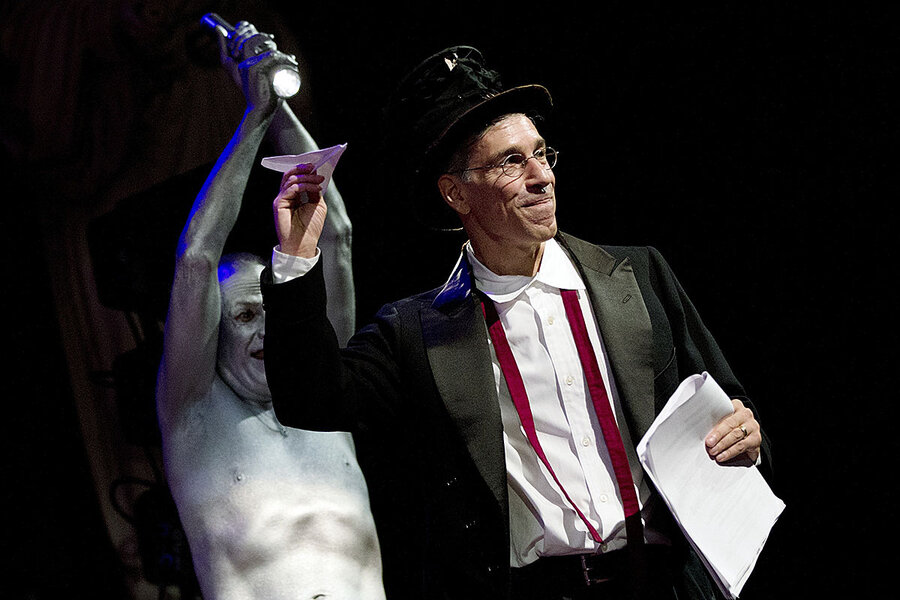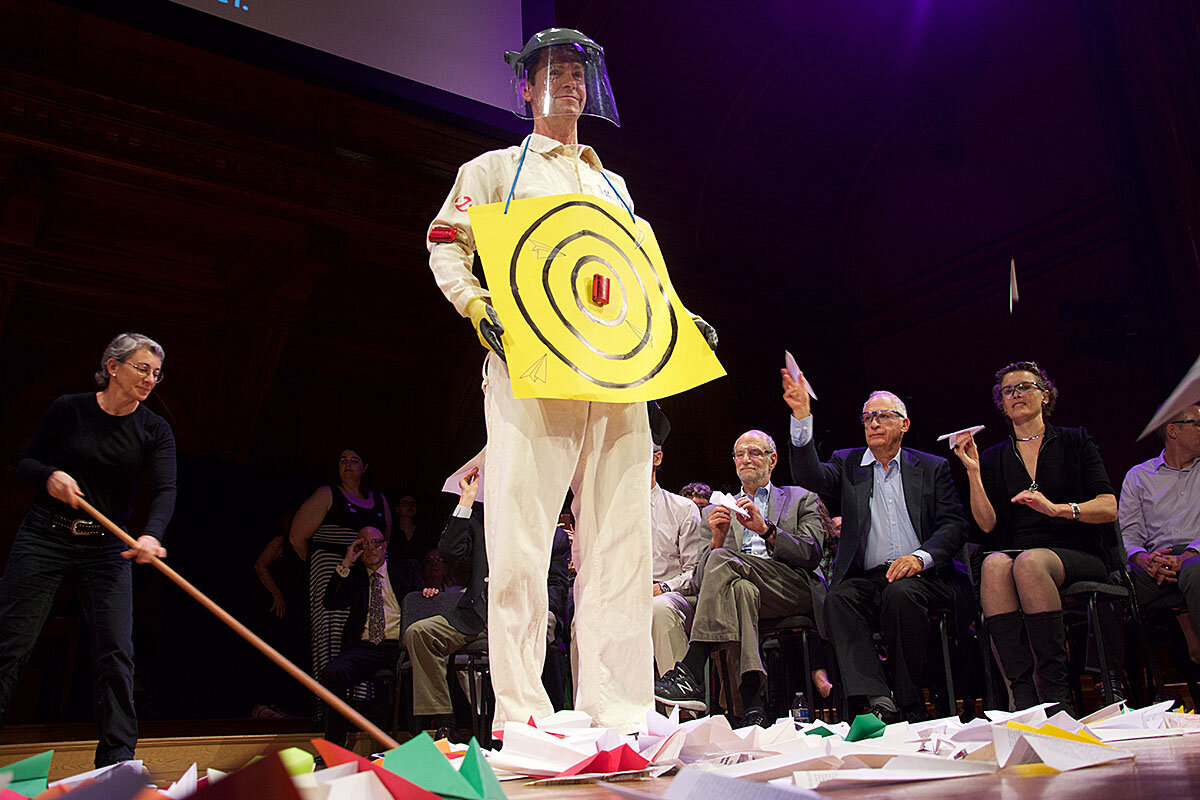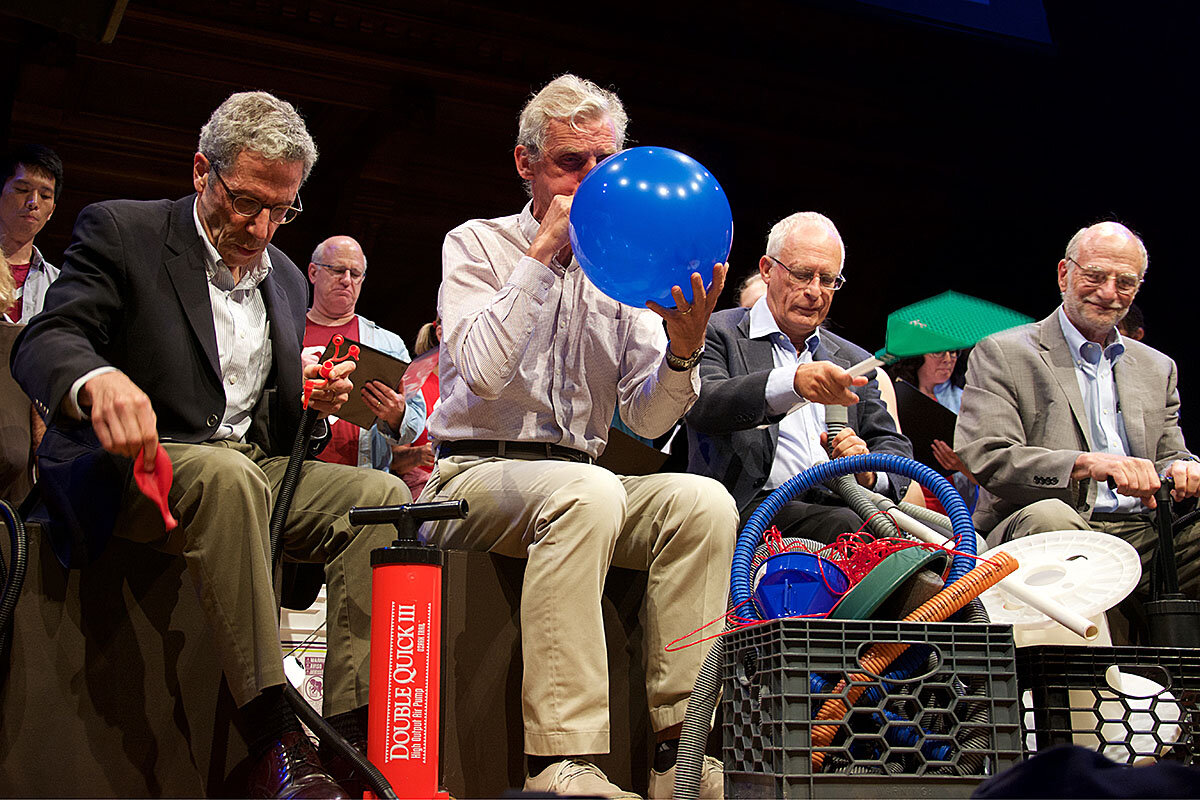At the Ig Nobel Prize awards, science meets silliness
Loading...
| Cambridge, Mass.
On Thursday evening at Harvard University’s elegant, 1,000-seat Sanders Theatre, four Nobel laureates wait on stage to present awards. “Human spotlights” wearing silver body paint and little else stand holding flashlights high. Once the ceremony gets under way, paper airplanes soar overhead. Scientists try to clean a painting with their saliva. Later, a Tesla coil discharges writhing purple sparks, the buzzing crackles echoing throughout the wood-paneled theater.
Held annually at Harvard, the Ig Nobel Prizes honor 10 achievements – usually scientific research – that first makes people laugh, and then think.
Winners of the 2018 prizes include scientists who found that chimpanzees imitate humans about as often and as well as humans imitate chimps, and researchers who measured the cleaning effectiveness of human saliva.
Why We Wrote This
An annual tongue-in-cheek awards ceremony at Harvard highlights the importance of play, lateral thinking, and outright frivolity in the natural sciences.
Science is often seen as a solemn discipline in which researchers contemplate weighty questions. The Ig Nobels are anything but that. But such silliness may hold a vital place in science.
“The tradition is that if there’s science and laughter together, something’s wrong. And in fact, it's almost the opposite, if you really pay attention,” says Marc Abrahams, founder of the Ig Nobels, which are in their 28th year. Quirky questions and simple curiosity can drive more serious scientific breakthroughs.
Dudley Herschbach, a professor emeritus of chemistry at Harvard, is no stranger to that concept. When he began his work using molecular beams to analyze chemical reactions, many senior scientists in the field “thought it was ridiculous to try,” Dr. Herschbach recalls. But it worked, opening up a wide variety of research possibilities, and earning Herschbach and colleagues the Nobel Prize in Chemistry in 1986.
Unconventional thinking typically drives Nobel Prize worthy breakthroughs, says Herschbach, who has participated in past Ig Nobel ceremonies. But such unbounded curiosity isn’t just rewarded in science, it’s also inherent.
“Scientists are really kids. They’re the ones who are really curious, and they never grow up. They stay curious. That’s an important aspect of science,” Herschbach says.
Some of the most famous scientists in history have embodied that unbridled curiosity about the world around them. Charles Darwin, for example, conducted what he called “fool’s experiments,” in which he challenged the obvious. In one, he placed some pollen from a male flower with an unfertilized female flower under a jar just to see whether they would interact with no pollinator present.
Some Ig-Nobel-winning findings have arisen from that same sort of pondering. For example, last year’s physics prize went to a scientist who investigated whether a cat could be considered both a solid and a liquid prompted by observations of felines pouring their bodies into various vessels.
Another previous winner, Andre Geim who won the Ig Nobel prize in 2000 for using magnets to levitate a frog, applied that same ingenuity to his work on graphene, which earned him and a colleague the 2010 Nobel Prize in Physics.
Sometimes exploratory research can lead more directly to big breakthroughs, too. Take the origins of Wi-Fi, for example. Stephen Hawking theorized in 1974 that black holes might not always be black, and a young Australian scientist was intrigued by that question. But when John O’Sullivan and colleagues set out to make observations that would test the theory, they found that the equipment wasn’t quite right. They made some adaptations, and the result is the backbone of modern Wi-Fi.
The questions posed and experimental setups may be quirky and inventive, but Ed Cussler, a chemical engineer and professor emeritus at the University of Minnesota, says scientists are still coloring within the lines when they approach them by using the toolbox of the scientific method.
Dr. Cussler himself won an Ig Nobel prize in 2005 along with colleagues for conducting an experiment that showed that, compared to swimming in water, people do not swim faster or slower in syrup. That question had dogged Isaac Newton and Christiaan Huygens, who had been in disagreement over it but had no way to test it themselves.
“The charm, to me, is not inventing new science to explain these phenomena,” says Cussler. “It’s using the science that’s been in your head in a way that you didn’t expect to.”








